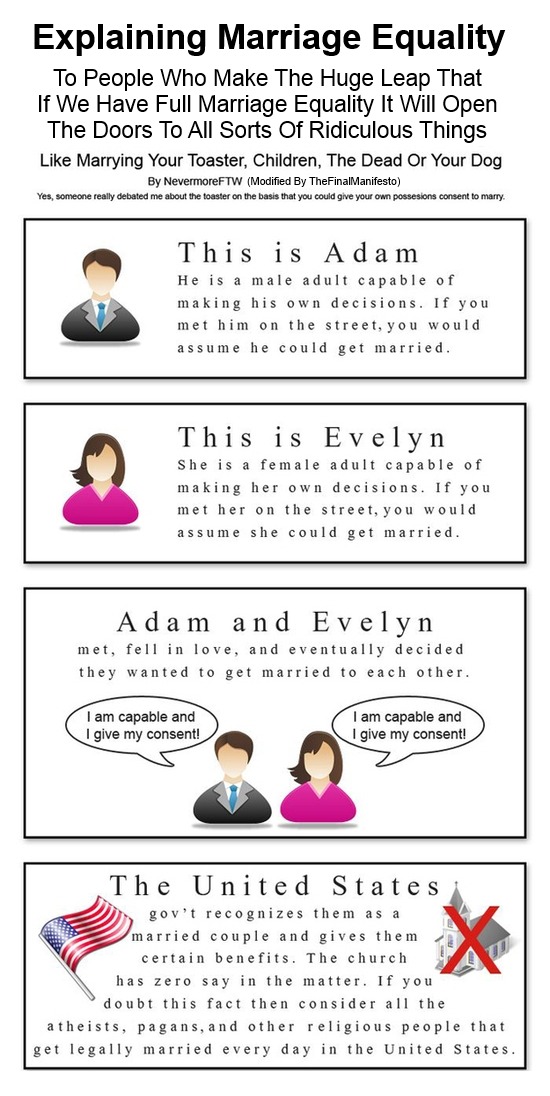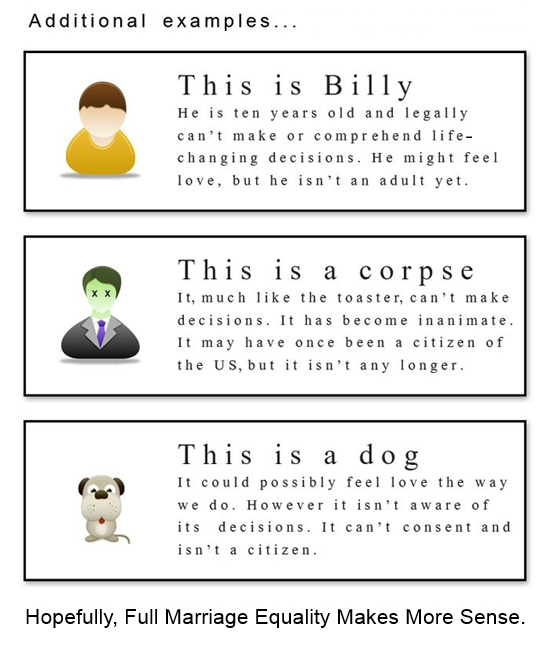This is definitely important. Not only is it wrapped up in issues of
sexism, and women's sexual and romantic rights, but it fundamentally
violates the whole idea of full marriage equality: the right to choose
who you love and spend your life with.
A young couple in Pakistan were tied up and had their throats slit
with scythes after they married for love, police said Saturday.
[...] The girl's mother and father lured the couple home late on Thursday
with the promise that their marriage would receive a family blessing,
said local police official Rana Zashid. "When the couple reached there,
they tied them with ropes," he said. "He (the girl's father) cut their
throats." Police arrested the family, who said they had been
embarrassed by the marriage of their daughter, named Muafia Hussein, to a
man from a less important tribe.
[...] Pakistani law means that even if a woman's killer is convicted, her
family are able to forgive the killer. Many families simply nominate a
member to do the killing, then formally forgive the killer. That's
what happened earlier this week, a lawyer said, when a tribal council in
central Pakistan's Muzaffargarh district sentenced another young couple
to death for marrying for love.
[...] The 19-year-old girl's family came to take her from her husband's
family, swearing on the Koran that they would not harm her and would
hold a proper wedding ceremony, he said. "During this the girl shouted,
cried and mourned for her life and her husband's life because she knew
that they will kill both of them," he said. The girl, named Mehreen
Bibi, was shot by a member of her family when she returned home, police
said. Her husband went into hiding and her father registered the murder
complaint so he could forgive the killer, Kiyyani said. "That will end
the case," he said.
That first case really gets at the core issue: the freedom to marry
undermines parents' ability to use their children as economic and
political tools. Many, many societies throughout most of history have
had some form of arranged marriage, and violation of
the parental prerogative to control their children's marriages has been
punished with varying severity. The more politically and economically
useful arranged marriage is to the broader family, the more severe the
punishment in that culture ends up being. The burden of this usually
falls hardest on daughters. The man involved is frequently seen as an
interloper or thief.
Such systems of marital control are deeply tied historically to the desire to control people's sexuality. (
And they can even survive the advent of entirely new religious world views.)
Traditionally sex and reproduction were controlled through marriage.
When marriage is seen as a fundamental part of how the social order
perpetuates itself - how parents, elders, and elites ensure their own
survival and accrue power - then any sexual or romantic behavior outside
of certain bounds violates society's sexual control of its members, and
thus the ability of elites to control their children's reproductive
lives. If the forbidden sexual behavior is also preferred only by a
minority, like consanguinamory or homoromanticism, then its rarity also
helps construct the view that it's abnormal and disgusting.
This is why, in societies with very tightly controlled arranged
marriage, you're much more likely to see the cultural denigration of
romantic love and love marriages. The rise of Protestantism coincided
with the rise of absolute monarchy and the eventual rise of the Nation
State. It's no coincidence that Protestant monarchs seized Catholic
assets and annulled Catholic laws. It's also no coincidence that Henry
VIII's Protestant Anglican church made the Monarch its head. It jived
perfectly with the idea of absolute Monarchy: that the Monarch was
granted authority by God.
It was during that time
that marriage laws in Europe became their most onerous. When one
violated the will of one's parents, one wasn't simply violating custom
or religious doctrine (which one technically wouldn't be under
Catholicism), one was violating the will of the State. By controlling
something as fundamental as the right to build families, the State was
establishing its newly constructed, centralized authority. The Catholic
church and Catholic nations followed suit.
And this gets at what marriage freedom is all about: the right to
construct one's family as one sees fit, and the right to have that
family validated by the state and be allowed to participate fully in
civil society. When regressives talk about gay marriage, and how
children need "one father and one mother," what they're really talking
about is the reproduction of a certain kind of society, generation upon
generation, through a certain kind of family. To acknowledge alternative
family structures, particularly in the context of reproduction and
adoption, is to acknowledge the validity of an alternate kind of
society.
Unfortunately for regressives,
that battle was lost hundreds of years ago.
We're already living in that alternate society. Their conception
relates to a specific vision built in the 1500s and 1600s. Enlightenment
and Romantic thought have already transformed the way we envision
ourselves. By returning power to the individual, the legitimacy of
authority has been stolen from the State and other large, coercive
social institutions. It doesn't mean individuals don't have a broader
obligation to their fellows or to society, but the State no longer has a
monopoly on how that obligation is defined.
This is tangentially related to a prohibition on homosexuality. The
idea of controlling people's sexuality, and in particular their long
term romantic relationships and families, is related to the desire to
determine who gets to build what kinds of families. However, homosexual
sex is not in-and-of-itself a challenge to that order, any more than
concubines are. Homosexual sex cannot produce children, and thus the
real danger is not homosexuality, but homoromanticism. This is why some
very patriarchal societies, which relied heavily on arranged marriage,
did not have any problem with homosexuality.
Consanguinamory is tied directly to the heart of this. When the
econo-political status quo was maintained by strictly defined racial
categories, interracial marriage became banned. To intermarry across
racial lines is to blur those racial lines, and thus to integrate the
two communities and subtly over time bring the whole system crashing
down.
Similarly, since "incest" taboos are historically related to who
you're not allowed to marry, and especially who you're not allowed to
have children with, it has functioned as
a key delineator of social groups, and a weapon by the elite.
They could violate it themselves, enhancing their appearance of being above natural and social laws, while
enforcing them against everyone else based on what served their own interests.
As the political structure and economic needs of societies have
changed, so have their taboos, with consanguineous marriage sometimes
being disadvantageous, and
sometimes being advantageous.
We're already in a brave new world. There's no going back. And thank
god for that, because the world's a better place for it. Now we just
have to finish the job.







